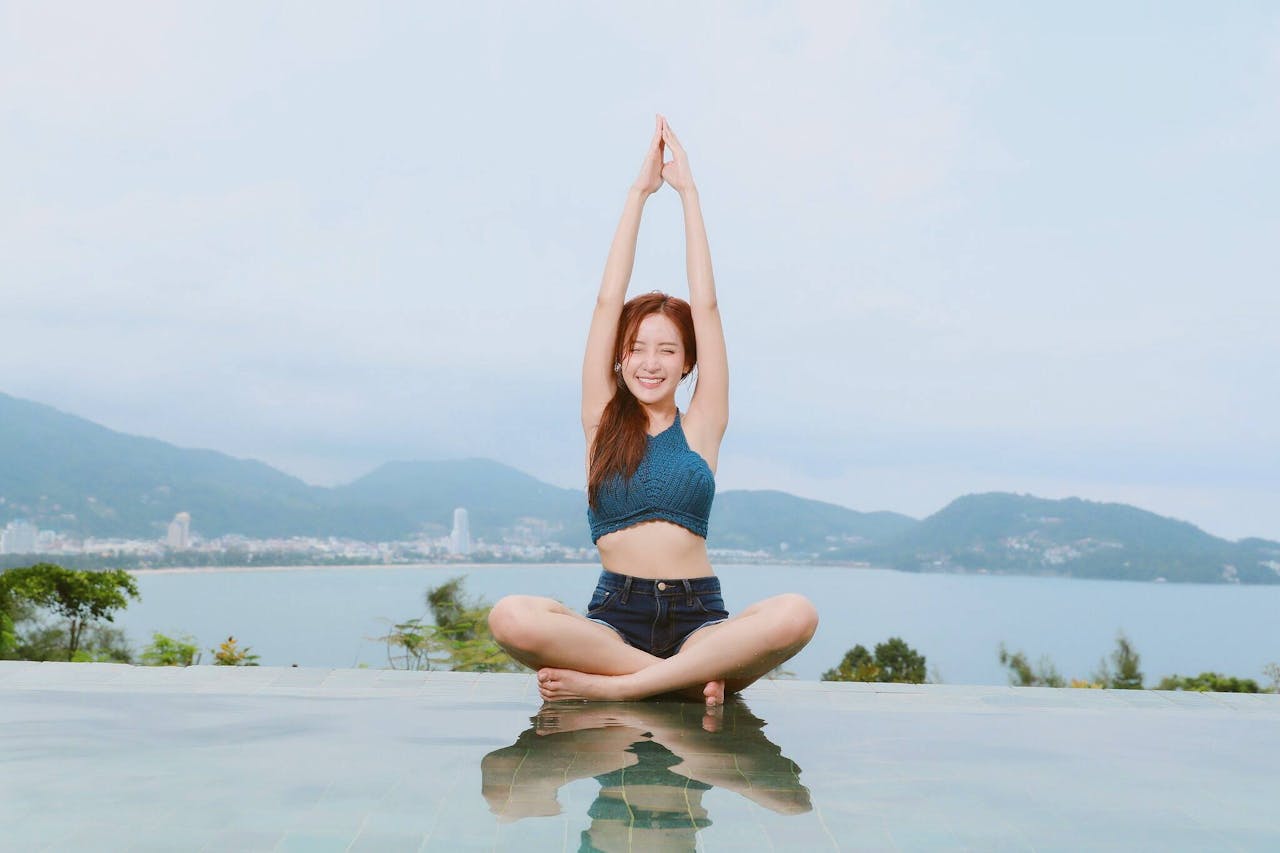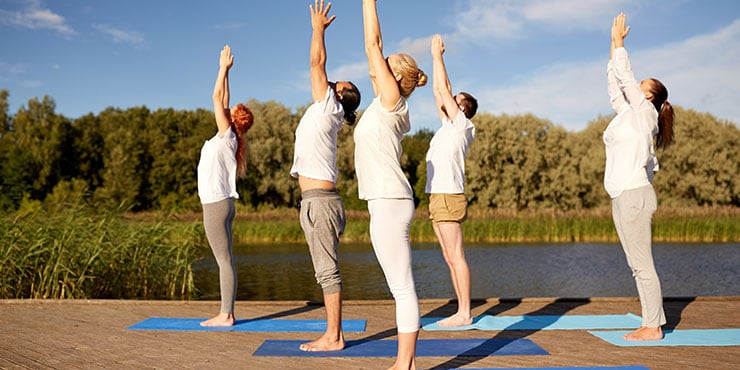
Table of Contents
Urdhva hastasana is a standing yoga pose that involves raising the arms overhead with palms facing inward. It is often used as a starting or transitional pose in a yoga practice, but also provides energy after long periods of sitting.
Introducing Urdhva hastasana - Palm Tree Yoga Pose
Urdhva Hastasana, commonly called Palm Tree Pose, is a standing yoga posture that involves stretching the arms straight toward the sky. It gets its name from the Sanskrit words, urdhva, meaning upward, hasta , meaning hand, and asana, meaning posture. It begins with the feet together and the knees straight and can be done with the palms touching, giving it the alternate names of the Upward Salute Pose and Raised Hands Pose. If an individual's shoulder flexibility is limited, they can keep their arms parallel with their hands shoulder-width apart.
Urdhva Hastasana is a variation of the foundation pose, Mountain Pose (Tadasana), as both involve raising the arms upwards and putting the body in a straight line. This pose is the second and second-to-last position in Surya Namaskar, or Sun Salutations, a common sequence of yoga postures.
Benefits of Urdhva Hastasana
The benefits of Urdhva Hastasana are similar to those for mountain pose and other standing yoga poses.
- Improves posture, balance, and body awareness: This pose improves posture, balance, and awareness as it requires a strong and stable foundation.
- Balances the heart chakra: Urdhva Hastasana activates and balances the heart chakra, which can lead to feelings of love and compassion towards oneself and others.
- Enhances flexibility and muscle strength: Urdhva Hastasana gently stretches the upper body to improve thoracic flexibility while strengthening the upper trapezius muscles, serratus anterior, and rhomboids.
- Energizes the body: Urdhva Hastasana can help to energize the body and increase feelings of vitality and alertness.
- Opens the lungs: It also helps to create space in the chest and lungs, which is therapeutic for asthma and congestion.
- Improves digestion: Practicing Urdhva Hastasana stimulates the Manipura chakra, which is associated with digestion and metabolism.
Contraindications of Raised Hands Pose
While Urdhva Hastasana is generally considered a safe and beneficial yoga pose, there are some contraindications to be aware of. Individuals with the following conditions should avoid or modify this pose:
- High blood pressure: Raising the arms overhead can cause a temporary increase in blood pressure, so individuals with high blood pressure should be cautious when practicing Urdhva Hastasana.
- Neck or shoulder injuries: Individuals with injuries to the neck or shoulders should avoid this pose or modify it by keeping their arms parallel to each other with their hands shoulder-width apart.
- Migraine or vertigo: This pose involves looking upwards, which can trigger symptoms of migraine or vertigo in some individuals.
- Pregnancy: Pregnant women may need to modify this pose to avoid putting too much pressure on the abdomen. Practitioners should consult with a healthcare provider before practicing yoga during pregnancy.
It is important to always listen to the body and modify or avoid any poses that do not feel safe or comfortable. Practitioners should consult with a healthcare provider or a qualified yoga teacher if they have any concerns or questions about practicing yoga.
How to Practice Upward Salute Pose
To practice Urdhva Hastasana, one should begin by standing with feet together and knee caps straight. If limited shoulder flexibility is an issue, practitioners should separate the arms and focus on lifting the shoulders and reaching upwards while keeping the elbows straight and arms parallel. Another option is to practice one arm at a time by holding it raised for five counts or longer, resting it, then switching to the other arm. Repeat this sequence three times for each arm and then reach with both arms.
Next, raise the arms overhead with the hands shoulder-distance apart and palms facing each other. The gaze can be lifted to the hands or kept straight ahead. Practitioners should hold the pose for several breaths, then release the arms down to the sides of the body. Urdhva Hastasana can also be incorporated into Surya Namaskar, or Sun Salutation, as the second or second to last position.
Step by Step Instructions for Salute Pose
To move into Urdhva Hastasana, practitioners can start in the tadasana mountain pose (one of the most relevant preparatory poses) with their arms by their sides. If using Urdhva Hastasana as part of a Surya Namaskara, or sun salutation, raise your arms to the side and then up, touching your hands above the body's center line. They can then make the next move, generally bending forwards and feeling their hands to their legs or the floor if possible.
- Start by standing at the top of the yoga mat with the feet together and arms resting at the sides.
- Inhale deeply, and as one exhales, slowly raise the arms forward towards the sky. Ensure the palms face inward and the arms straight throughout the movement.
- Continue to raise the arms until they are fully extended above the head. Ensure the shoulders are relaxed and away from the ears, maintaining the gaze forward or toward the hands.
- Hold the pose for several deep breaths, focusing on lengthening your spine and lifting your chest towards the sky.
- Gently release as one exhales and slowly lower the arms back down.
Keeping the knees straight and the feet firmly planted on the ground throughout the pose is essential. Practitioners with limited shoulder flexibility can keep their arms parallel with their hands shoulder-width apart. To deepen the stretch, one can try interlacing their fingers and turning their palms to face up towards the sky.
Option: To deepen the stretch, practitioners can try interlacing your fingers and turning your palms to face up towards the sky.
Raised Arms with Straight and Upward Gaze
To perform the arms raise, the practitioner should raise their arms while keeping their chin parallel and gaze upwards and forwards. Alternatively, they can look up as they lift their arms, gazing upwards. The practitioner can pull their head up and back to ensure a long neck, naturally lifting their chest. Then, they can smoothly lift their shoulder blades and arms.
Enhancing Thoracic Spine Posture in Urdhva Hastasana
To improve rib cage posture in Urdhva Hastasana, the practitioner can focus on creating a smooth backbend in their thoracic spine when lifting their chest. To start, they should stand tall in one line and make a downward pull on the backs of their ribs to lift the front ribs, ensuring a continuous bend from the base of their thoracic spine to the top.
If the practitioner has difficulty feeling their thoracic spine, they can concentrate on their neck posture by pulling their ears back and up while standing upright with arms down, keeping the crown of their head pointing up or slightly forward. They should focus on the length of the back of their neck and adjust their head position accordingly.
Next, the practitioner can focus on the lower front ribs, which are on either side of the ribcage arch. They should pull the ribs inward towards each other and hold this sensation while lifting their arms and maintaining posture. The practitioner may feel muscular tension at the back of the ribcage, but they should try to keep this tension to enhance their thoracic spine posture in Urdhva Hastasana. Practitioners will not get a good stretch if their arms are in a V shape, and they should try to get them as close to their ears as possible.
Balancing in Urdhva Hastasana
To stay balanced in Urdhva Hastasana, the practitioner should start by standing with their feet together and practice mountain pose. They can place their big toes touching and heels slightly apart or have their heels and big toes touching. The practitioner should adjust their foot position by rotating slightly inward or outward for comfortable knees and hips.
When standing with feet together, the practitioner has a smaller base of support compared to standing with feet hip-distance or shoulder-width apart. Lifting their arms overhead increases their center of gravity, making it easier to lose balance. Shift the weight forward, press down with the toes, engage the core muscles, and root down through the sit bones. Bringing weight into all four corners or outside edges of the feet will also make it easier to balance.
Alternatively, the practitioner can shift their weight slightly forward and actively press down with their toes. Doing so may require rotating their shins relative to their feet. They will find pressing down their outer toes with greater external rotation and lifting their inner arches easier. Internally rotating will help them press their big toe down and flatten their inner arches.
Stretching the Entire Body in Urdhva Hastasana
 When done correctly, Urdhva Hastasana can provide a full body stretch. The practitioner lifts their arms and reaches towards the sky, engaging their shoulders. The tops of the shoulders are brought inward, and the inner elbows are straightened to stretch the upper arms, even if the hands don't touch.
When done correctly, Urdhva Hastasana can provide a full body stretch. The practitioner lifts their arms and reaches towards the sky, engaging their shoulders. The tops of the shoulders are brought inward, and the inner elbows are straightened to stretch the upper arms, even if the hands don't touch.
To lengthen the neck, draw the earlobes back and up. Lift and expand the ribcage in all directions to stretch the spaces between the ribs and waist - front, sides, and back. The tailbone is gently dropped to open the back of the lumbar spine.
The practitioner can generate a body stretch in their inner thighs by reaching their knees away from their hip joints. They can adjust the stretch by rotating their knees inward or outward. They can spread their toes and fingers to extend the stretching sensation from the tips of their toes to their lower legs and beyond. To stretch the lower legs, rotate the shins outward and lift the inner arches. Simultaneously, the inner forefoot or base of the big toe is pulled back and down.
Counter Poses for Upward Salute
Counter poses will help to balance the effects of holding Urdhva Hastasana for extended periods. One such pose is Prasarita Padottanasana C position, also known as Dwikonasana. The practitioner can clasp their hands behind their back and lift their arms, stretching the shoulders.
Another option is to reach the arms back without clasping the hands, strengthening and stretching the shoulders. It is important to practice both arm positions, with and without the hands clasped, to maintain balance in the body.
Advanced Poses Following Urdhva Hastanasana
After Urdhva Hastasana, there are several more advanced poses that a practitioner can attempt, depending on their level of experience and flexibility. Here are a few examples:
- Uttanasana: From Urdhva Hastasana, the practitioner folds forward at the hips and brings their hands down to the ground or to blocks, with the legs straight or slightly bent. This is one of many inverted poses that stretches the hamstrings and lower back.
- Adho Mukha Svanasana: From Uttanasana, the practitioner steps back into a plank pose, and then lifts their hips up and back to downward facing dog pose. This pose stretches the entire back body and strengthens the arms and shoulders.
- Chaturanga Dandasana: From plank pose, the practitioner lowers down halfway to the ground, keeping the elbows close to the body, and then presses back up to plank pose. This pose strengthens the arms, chest, and core.
- Bakasana: From downward facing dog, the practitioner steps forward and comes into a squat position with the feet together. They then place their hands on the ground, shoulder-width apart, and lean forward, lifting their feet off the ground and balancing on their hands. This pose strengthens the arms and core, and requires balance and focus.
References
(PDF) THERAPEUTIC EFFECT OF YOGA IN MANAGEMENT OF OBESITY
Upward Salute (Urdhva Hastasana)
Disclaimer
The contents of this article are provided for informational purposes only and are not intended to substitute for professional medical advice, diagnosis, or treatment. It is always recommended to consult with a qualified healthcare provider before making any health-related changes or if you have any questions or concerns about your health. Anahana is not liable for any errors, omissions, or consequences that may occur from using the information provided.

By: Anahana
The Anahana team of researchers, writers, topic experts, and computer scientists come together worldwide to create educational and practical wellbeing articles, courses, and technology. Experienced professionals in mental and physical health, meditation, yoga, pilates, and many other fields collaborate to make complex topics easy to understand.
